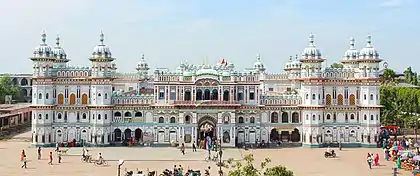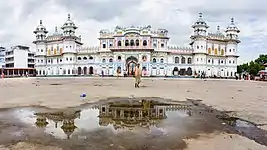Janaki Mandir
Janaki Mandir (Nepali: जानकी मन्दिर) is a Hindu temple in Janakpurdham, Nepal, dedicated to the Hindu goddess Sita. It is an example of mixed Hindu Maithil architecture.[1] Fully built in bright white and constructed in an area of 1,480 square metres (15,930 sq. feet) in the Mithila Kingdom, it is a three-storied structure made entirely of stone and marble. [2]
| Janaki Mandir | |
|---|---|
जानकी मन्दिर | |
 Front view of Janaki Mandir | |
| Religion | |
| Affiliation | Hinduism |
| District | Dhanusa District |
| Province | Madhesh Pradesh |
| Deity | Janaki, Rama |
| Festivals | Vivaha Panchami, Rama Navami, Dashain, Tihar-Deepawali and Chhath |
| Location | |
| Location | Janakpurdham |
| Country | Nepal |
 Location in Nepal | |
| Geographic coordinates | 26°43′50″N 85°55′32″E |
| Architecture | |
| Type | Hindu-Kushwaha |
| Creator | Queen Vrisha Bhanu of Tikamgarh |
| Completed | 1967 BS (1910 AD) |
| Specifications | |
| Temple(s) | 70 |
| Monument(s) | 27 |
| Elevation | 78 m (256 ft) |
The walls of the temple have beautiful Mithila (Madhubani) paintings. All its 60 rooms are decorated with the flag of Nepal, coloured glass, engravings, and paintings, with beautiful lattice windows and turrets. According to legends and epics, King Janak ruled Videha Kingdom from this part of Janakpur during the Ramayana period. His daughter Janaki (Sita), during her swayambar (marriage), had chosen Lord Rama as her husband and become the queen of Ayodhya. Their marriage ceremony had occurred in the nearby temple, which is also called vivaha mandap near the temple itself that was later reconstructed by Amar Singh Thapa. The site was designated as a UNESCO tentative site in 2008.[3]
History
The mandir is also popularly known as the Nau Lakha Mandir (meaning "nine lakhs"). The cost for the construction of the temple was about the same amount of gold coins: nine lakhs or nine hundred thousand gold coins, hence the name. Queen Vrisha Bhanu of Orchha State (also known as Urchha, Ondchha and Tikamgarh) built the temple in 1910 AD. This temple lies at Janakpur, Nepal.
In 1657, a golden statue of the Goddess Sita was found at the very spot, and Sita is said to have lived there. The legend said it that it was built on the holy site where Sannyasi Shurkishordas had found the images of Goddess Sita. In fact, Shurkishordas was the founder of modern Janakpur and the great saint and poet who preached about the Sita Upasana (also called Sita Upanishad) philosophy. Legend has claimed it that King Janak (Seeradhwaj) performed the worship of Shiva-Dhanus on this site.
As of 26 April 2015, the temple is reported to have partly collapsed from the earthquake in April 2015.[4]
Pilgrimage
Every year, thousands of pilgrims from Nepal, India, Sri Lanka, and other countries visit Ram Janaki Temple to worship Lord Ram and Sita. Many worshippers visit the temple during the festivals of Ram Nawami, Vivaha Panchami, Dashain and Tihar.
Gallery
 Panoramic view (2016)
Panoramic view (2016).jpg.webp) Front view (2007)
Front view (2007)_captured_on_Nov._02%252C_2012..JPG.webp) Sunset view (2012)
Sunset view (2012)_as_seen_in_the_early_morning_of_Nov._02%252C_2012..JPG.webp) Early morning view (2012)
Early morning view (2012) Inside view
Inside view Ganga Sagar
Ganga Sagar
Near By Temples
- Lakshman Mandir
- Ram Janaki Biwaha Mandap
- Raj Devi Mandir
- Ram Mandir[5]
References
- "Janaki Temple Mughal Architecture in Nepal".
- "Janaki Mandhir". Lonely planet. 30 July 2017. Retrieved 30 July 2017.
- "Ram Janaki Temple".
- "Nepal Earthquake Takes Heavy Toll on Temples". NDTV. 26 April 2015. Retrieved 3 May 2015.
- "Janaki Mandir, Janakpur (Nepal)- the Birthplace of Goddess Sita - Holidify".
External links
- Sita Upanishad
- Janaki Mandir on Google Maps
- Janki Mandir Archived 2022-08-27 at the Wayback Machine official Website
.jpg.webp)
